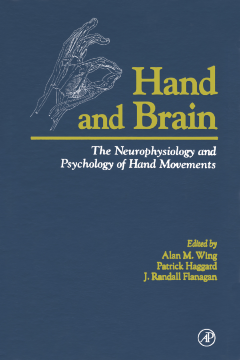
Additional Information
Book Details
Abstract
Used for gestures of communication, environmental exploration, and the grasping and manipulating of objects, the hand has a vital role in our lives. The hand's anatomical structure and neural control are among the most complex and detailed of human motor systems.
Hand and Brain is a comprehensive overview of the hand's sensorimotor control. It discusses mediating variables in perception and prehension, the coordination of muscles with the central nervous system, the nature of movement control and hand positioning, hand-arm coordination in reaching and grasping, and the sensory function of the hand.
In the last decade the rapid growth of neuroscience has been paralleled by a surge of interest in hand function. This reflects the fact that many of the fundamental issues facing neuroscientists today--including the problem of relating physiology to behavior--are central to the study of sensorimotor control of the hand. This book takes a broad interdisciplinary perspective on the control of hand movements that includes neurophysiology, neuroanatomy, psychology and neuropsychology, and biomechanics.
The authors, who have all made significant scientific contributions in their own right, have sought to introduce their chosen topics in a manner that the undergraduate reader will be able to follow without sacrificing detailed and up-to-date coverage ofthe major developments.
Uses an interdisciplinary approach including behavioral and neurophysiological data
Describes a variety of experimental methodologies
Treats neural computations necessary for the control of movement
Covers implications of biomechanics for control, sensory mechanisms, and perceptual processing (haptics)
Includes manipulative hand function as well as reaching
Overviews each group of chapters using link sections
Contains an integrated index and a glosssary
The five sections cover:
Mediating variables in perception and prehension
The coordination of muscles with the central nervous system
The nature of movement control and hand positioning
Hand-arm coordination in reaching and grasping
The sensory function of the hand
The editors have done an admirable job of selecting authors whose work represents many of the dominant approaches to studying the psychological, physiological, and neural basis of hand function. The chapters are well-written. This volume would also be a useful reference for researchers looking for an up-to-date synopsis of research in a specialty area authors maintain an integrative approach, linking their research to broader theoretical or applied issues, which is certain to create a sense of excitement about the area and a thoughtful consideration of the issues. This book does an excellent job of highlighting the different methodological approaches taken to understand sensorimotor control. In summary, this book conveys the excitement and importance of an area, which until recently has been treated with little enthusiasm or interest by psychologists. The emergence of neuroscience is rapidly altering this view, and this edited volume illustrates why sensorimotor control is a particularly good example of a truly integrative, multidisciplinary field.
--CONTEMPORARY PSHYCHOLOGY
The editors have assembled an all-star cast of experts with each one focusing on a seminal series of experiments from his or her own laboratory. This diversity of expertise is one of the strengths of this book because the editors have made some real effort to co-ordinate the content and provide cohesiveness in the style and presentation. This book provides a solid and accessible introduction to motor control of the hand...it is eminently readable and has an extensive glossary. The topics covered are ofhigh quality and authored by acknowledged experts.
--TRENDS IN NEUROSCIENCE
Chapters are well-written and nicely complemented by numerous figures and line drawings. The 'jargon-level is purposely kept low so that the material lies within the reach of upper-division undergraduate and beginning graduate students. This book should appeal to individuals involved in physical therapy and robotics as well as to workers in the field and their students.
--D.M. SENSEMAN, Universty of Texas at San Antonio
